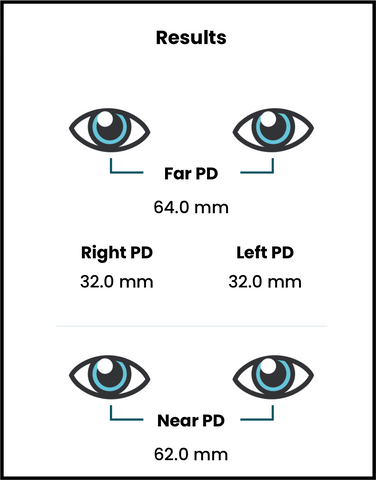What is pupillary distance and how to measure it yourself
If you're shopping for new glasses, you already know that an up-to-date prescription is a must, but are you aware of the importance of knowing your pupillary distance?
If written on your prescription by your optometrist, Pupillary distance will appear as “PD”. Unfortunately, oftentimes doctors don't write this value down, and you're none the wiser on how necessary your pupillary distance is when purchasing new frames.
What is pupillary distance, and why is it important?
Your PD is the distance between your pupils. It's pretty straightforward yet often overlooked a—without it, your prescription can't be accurately fulfilled.
PD (measured in millimeters) is the distance between the centers of your pupils. Your specific PD is used to determine the center of your prescription on your glasses. Therefore, it's essential to have this measurement be as accurate as possible to provide you with the proper vision correction. If your PD is incorrect, your vision may be affected—resulting in potential eye strain, fatigue, headaches, and blurry vision (not good!).
You'll find your pupillary distance written on your prescription either as one whole number (eg. 63) or as two separate values per eye, as seen here, which then need to be added together.

Pupillary distances are recorded per your vision needs. Your doctor may provide you with one overall measurement, measurements that are broken down per eye, or detailed measurements that include your near and far PD.
- Far PD: Refers to the distance between your pupils when viewing a distant object.
- Near PD: Refers to the distance between your pupils when viewing objects close-up, such as reading.
How to obtain your PD from your optometrist:
At your scheduled appointment make sure to specifically request that your optometrist write down your PD on your prescription. Doctor’s frequently omit PD from prescriptions as an oversight, believing you’ll be purchasing your frames through them.
Simply advise your optometrist that you’re looking to purchase frames online and will need your PD to do so.
If, by chance, you’ve already received your prescription and your PD is not present, try giving your doctor a call to request your pupillary distance. Your optometrist should already have your PD on file—it doesn't hurt to ask for it.
If your optometrist did not jot down your PD, there's no need to worry; there are various ways to measure it yourself and get accurate results.
How to use an app to measure your PD:
In the modern age of finding all of the answers to life's many questions at the end of a keyboard and mouse click, it's no surprise that we can find something as simple as our pupillary distance online in seconds.
Of course, finding the right app can be tricky, so Hubble narrowed down a few apps we've used ourselves and trust to provide you with an accurate PD.
EyeQue PD Check: This app is free of charge and is available on the Apple Store and GooglePlay. This app measures the far pupillary distance of both your left and right eye for distance viewing and measures your near PD for near viewing. They currently have a 4.9/5 rating and have 246 reviews. Open your newly downloaded app, hold the phone as still as possible right in front of your face, and the app will guide you to the best distance for accurate results. Your results will show you a Far PD, right eye PD, left eye PD, and a Near PD. You can remeasure as many times as you need to confirm the most accurate results.

Bonlook Inc: EyeMeasure is a free app that gives you a PD measurement for near and far focal lengths; no mirrors, credit cards, tape measurers, or objects of any kind are needed. This app works for iPhone and iPad devices with facial recognition software and claims to be accurate up to 0.5mm providing the ideal prescription PD reading. Once you've downloaded the app, simply hold your phone directly in front of your face, about a foot away, and the app will automatically begin to scan your PD. You'll then be advised that your results are ready to be viewed—with a near and far pupillary distance.

GlassifyMe: This app costs $4.99 and provides an automatic PD measurement within seconds. This app will give you a distance, reading, computer, and VR PD, along with mm measurements per eye. GlassifyMe can be downloaded for Apple and Android devices. Check out their website for more information. This app has a 4.6/5 stars rating with 2.5K reviews on the Apple app store.

How to measure your PD yourself:
If your optometrist doesn’t have your PD and the apps did not work out for you there is still a way to obtain your pupillary distance yourself.
Simply grab a mirror, a ruler, and follow these simple steps to obtain your PD.
- Stand 8 inches away from your mirror.
- Keep your face as straight as possible and place the ruler against your eyebrows.
- Next, you'll want to close your right eye and place the ruler's 0mm mark above the center of your left pupil.
- Keep looking straight and open your right eye while closing your left eye.
- The distance between the ruler's starting point and the center of your right eye's pupil is your PD.
It's that simple! Now, you have your PD, and you're on your way to getting those trendsetting frames online.
Pro Tip: The average PD for women is 60mm, 62mm for men, and 43-54mm for kids. Also, we recommend taking your measurement at least twice to confirm a precise result.
It's time to get some stylish frames online.
You've got your up-to-date prescription with your PD included; it's time to start shopping for some trendsetting Frames by Hubble.
Enjoy frames from our Custom Hubble Collection or our new Hubble Approved Frames Collections, Tortoise, Trendsetter, Crystal, Timeless, Bespoke, and Kids. With Frames by Hubble starting at only $48, you're ready to get fashionable frames that will have everyone asking, "Where did you get those glasses?"



